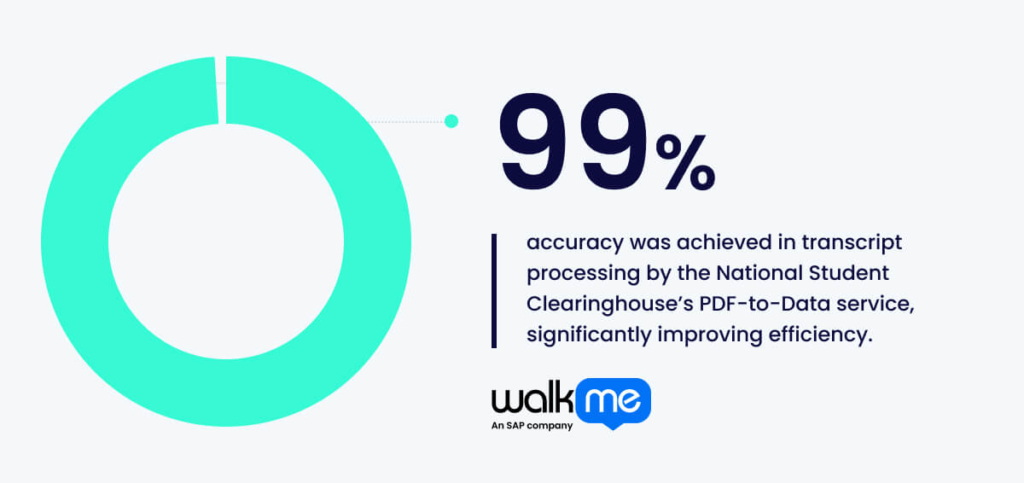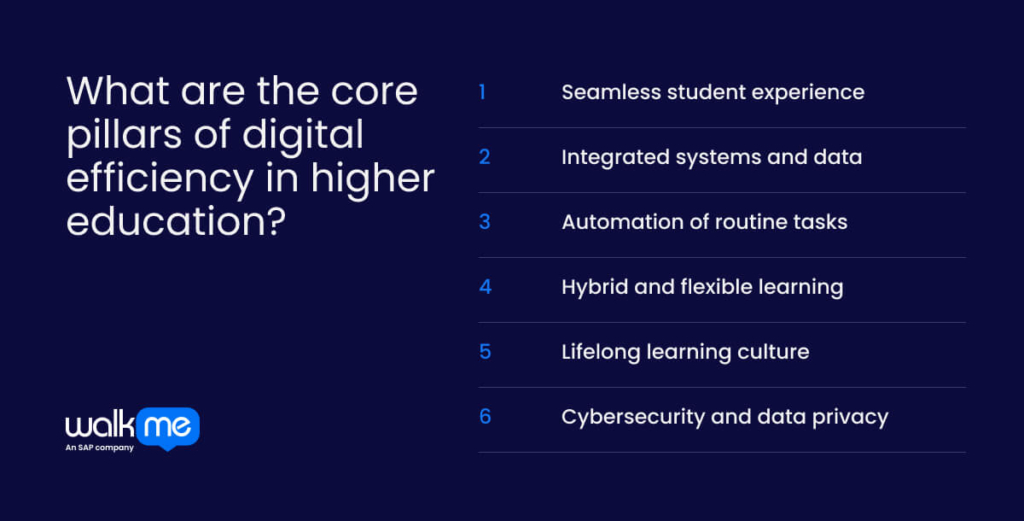Digital efficiency standardizes digital workflows and automates administrative tasks without requiring an increase in headcount.
Timetabling, admissions, grading, and academic advising are being updated with digital tools designed to reduce effort and improve accuracy.
Universities that view digital efficiency as a technical challenge, rather than just a staffing issue, are making real progress.
With that in mind, this article looks at how digital efficiency improves daily operations, leads to better student outcomes, and supports innovation as universities respond to new challenges.
What is digital efficiency in higher education?
In higher education, digital efficiency is applying the right tools to simplify processes and reduce manual workloads across departments.
For example, scheduling software can auto-allocate classrooms based on faculty availability and transcript requests. This was once a process that required physical forms, and can now be completed through online portals.
Digital efficiency focuses on refining existing processes to reduce steps and errors in routine tasks, rather than introducing entirely new systems.
In contrast, digital transformation aims for large-scale reinvention, but efficiency delivers faster, focused gains by improving what already works.
Why is digital efficiency important in higher education?
Reducing digital complexity in universities remains a top priority as budget pressures rise and enrollment needs change.
Digital efficiency helps cut unnecessary workload and improves accuracy in administrative tasks. This gives institutions more space to focus on teaching quality and student support.
Likewise, the National Student Clearinghouse’s PDF-to-Data service improved transcript processing with over 99% accuracy. This reduced manual data entry and let staff spend more time with students.

These changes improve student satisfaction and build stronger institutional digital resilience. They show that efficiency efforts bring real value, beyond saving money or adding new tools.
What are the core pillars of digital efficiency in higher education?

The core pillars of digital efficiency in higher education are central to improving how institutions operate under pressure. Understanding where time, effort, and resources are lost helps universities adapt without increasing overhead.
Let’s take a closer look at the core pillars of digital efficiency in higher education:
Seamless student experience
Students often have to use many different systems for admissions, course registration, and financial aid. Digital efficiency brings these services together into one easy-to-use system. This reduces waiting times and minimizes oversights caused by manually entering information.
For example, adaptive chatbots answer common student questions, allowing advisors to spend more time addressing complex issues. Responses are much faster, and staff satisfaction is significantly improved. Making these processes smoother helps more students stay in education and succeed by removing unnecessary hurdles.
Integrated systems and data
Universities often use separate systems for enrollment, grading, and campus services. This typically results in errors in data and duplicated work. Linking these systems into a unified communications solution enables updates to occur in real-time.
For example, if a student changes their major, all related departments are automatically updated. This reduces data errors and helps speed up reporting. Sharing data across departments also aids resource allocation and supports students who need extra help.
Automation of routine tasks
Tasks such as attendance recording and fee billing consume a significant amount of staff hours and risk human error. Automation platforms now handle these workflows end-to-end, flagging anomalies for review without manual oversight.
For instance, automatic transcript verification lowers processing time from days to hours while improving accuracy. Such automation reduces IT costs, allowing staff to focus on curriculum design and personalized student support.
Hybrid and flexible learning
Coordinating both in-person and remote learning needs tools that bring course delivery and assessment tracking together in one place. Digital systems connect live classes, recorded videos, and assignments, allowing students to access them easily.
Schedules update automatically to fit changes in how students attend, whether in person or online. Grading remains fair and consistent, and automatic feedback helps students learn more effectively. This adaptability supports various learning styles, utilizes campus space effectively, and enables teachers to manage their time more equitably.
Lifelong learning culture
Alums and working professionals want simple access to ongoing education, short courses, and skill updates. Digital adoption platforms (DAPs) track their progress after graduation and recommend classes that align with their career goals.
Connecting these platforms with employers makes sure certifications are recognized. Automating enrollment and certificate delivery speeds up the process and lessens the hassle. This digital support keeps learners engaged throughout their careers. It also helps universities improve their reputation and generate more revenue from continuing education.
Cybersecurity and data privacy
Universities collect a significant amount of personal data, including grades, addresses, and financial details, making them a prime target for cyberattacks. Digital efficiency means using smart, secure tools like multi-factor authentication to spot and stop threats quickly.
It also includes clear data policies that everyone can follow. Automated systems help schools comply with privacy laws, such as FERPA and GDPR. These systems significantly lower the risk of fines and protect the school’s reputation.
What strategies are available to universities to accelerate digital efficiency?
Higher education institutions face growing pressure to optimize resources while maintaining quality and accessibility.
Identifying effective strategies for digital efficiency is essential. It ensures that operations lead to purposeful, measurable outcomes rather than isolated technology projects.
Let’s take a closer look at the available strategies for universities hoping to accelerate digital efficiency:
Invest in edtech platforms
Running multiple systems for grading, timetabling, and records management can lead to errors and wasted time. Edtech platforms replace scattered tools with one system that connects everything, including students, faculty, and services.
Updates also sync in real time, meaning no one works with outdated information. Fewer logins mean fewer mistakes, saving time and helping departments work in unison instead of duplicating effort behind the scenes.
Focus on student-centered design
Tools should align with how students interact with the university, rather than how departments are organized. Interfaces must be simple, mobile-friendly, and built around real needs.
Universities that map digital processes to the student experience reduce confusion and cut support requests. Clear design always improves outcomes because students spend less time figuring out systems and more time learning.
Develop digital skills
Buying new tech won’t help if staff and faculty don’t know how to use it competently. Training must go beyond software basics. It should teach staff how to adapt processes, troubleshoot problems, and make smarter choices with digital tools.
Universities that invest in practical training see fewer delays and more confident users. In this regard, digital efficiency improves when everyone makes the most out of the available tools.
Collaborate with industry partners
Universities don’t need to build everything in-house. Partnering with tech firms gives access to proven tools and real-world expertise. For example, collaborating with an edtech company can accelerate the development of a course app or scheduling tool.
These partnerships also help align platforms with actual user behavior. Choosing the right partner reduces trial-and-error costs and brings well-tested digital systems into higher education faster.
Use data to drive decisions
Good data helps universities spot problems early on and track whether systems are working. For instance, tracking support tickets can show which processes confuse students the most.
User behavior analytics (UBA) can also flag bottlenecks in enrollment or low usage of certain tools. When data guides planning, resources go where they’re needed most. Efficiency improves because decisions are based on what is actually happening, not on guesswork or tradition.
Enhance cybersecurity practices
More campus systems are moving online, meaning security risks are rising. This is especially true for universities, where many academic systems are linked. One breach can expose thousands of student records or shut down important services.
Digital efficiency means protecting data without slowing people down. Tools like two-factor authentication and automatic system checks help keep systems secure. Building strong security into daily tasks prevents problems. It also cuts costs by avoiding recovery after attacks.
What are some real-world examples of digital efficiency in higher education?
Looking at real-world examples of digital efficiency in higher education is a great way to understand how practical changes can improve student services, reduce costs, and simplify campus operations.
We’ve researched three real-world examples from educational institutions across the United States to provide you with a clear picture of how digital efficiency is being applied and the results it delivers.
Let’s take a closer look at some real-world examples of digital efficiency in higher education:
University of Arkansas
Before the change, services like class registration, financial aid, and academic advising were handled separately, which often caused delays and disarray. Now, students use one app to manage everything from schedules to tuition.
Staff can view accurate data across all campuses and respond more quickly. Credit transfers between schools also became easier through a shared course numbering system.
As a result, more students are graduating on time, and the system has saved a significant amount of money by cutting down on outdated tools.
Arizona State University (ASU)
ASU has invested in connected digital tools to simplify nearly every part of the student experience. In 2024, the university expanded its use of online systems that support class enrollment, financial aid, and personalized academic advising.
These tools use real-time data, so staff can reach out to students early if they’re falling behind. Students can check everything from grades, payments, and appointments on their phones.
ASU reported an 85% first-year retention rate, along with higher student satisfaction, especially among first-generation college students. This improvement comes from services that are easier to access and no longer slowed by unnecessary delays.
University of California, Berkeley
UC Berkeley Library took steps to make its vast collections more accessible by supporting controlled digital lending. This allows copyrighted books to be scanned and loaned digitally, with the same restrictions as physical copies. Only one user can access a copy at a time, and the library can lend out only as many digital copies as it owns in print.
It’s a legally supported model that helps students and researchers access rare or in-demand materials remotely. For those studying off-campus or needing flexible options, this reduces wait times and improves learning access without breaking copyright laws.
It also gives libraries a way to share valuable resources more fairly, especially with students who can’t easily visit campus.
What’s next for digital efficiency in higher education?
As you’ve seen, digital efficiency in higher education is a complex topic with many moving parts.
Universities are starting to move faster, make smarter decisions using data, and take efficiency seriously. When investments are made in digital systems, students and faculty benefit with better outcomes and stronger support.
Digital adoption will also be crucial, as universities train their staff and students to maximize the benefits of evolving tech.
It’s an exciting time, with new tools and innovations emerging every day, from AI transformation to next-gen workflow automation.
The future of learning depends on how we apply these innovations to improve outcomes that ensure lasting impact. Now it’s up to institutions to act and drive long-term change for future generations.
FAQs
Universities assess digital efficiency by tracking how quickly tasks are completed, counting errors, and measuring time or cost savings. They also ask students and staff if digital tools are easy to use. When processes like registration or grading run more smoothly, it shows that the digital systems are effective.
Student feedback is vital because it reveals what is working and what needs improvement. When students share their experiences, universities can make better decisions to improve technology. This, in turn, helps create a smoother learning experience for everyone.
Smaller schools can improve digital efficiency by starting with simple, low-cost tools that automate basic tasks. Training staff to use existing systems is also a budget-friendly way to maximize current technology use. Sharing resources and ideas with other schools can save money and boost digital efficiency progress.

